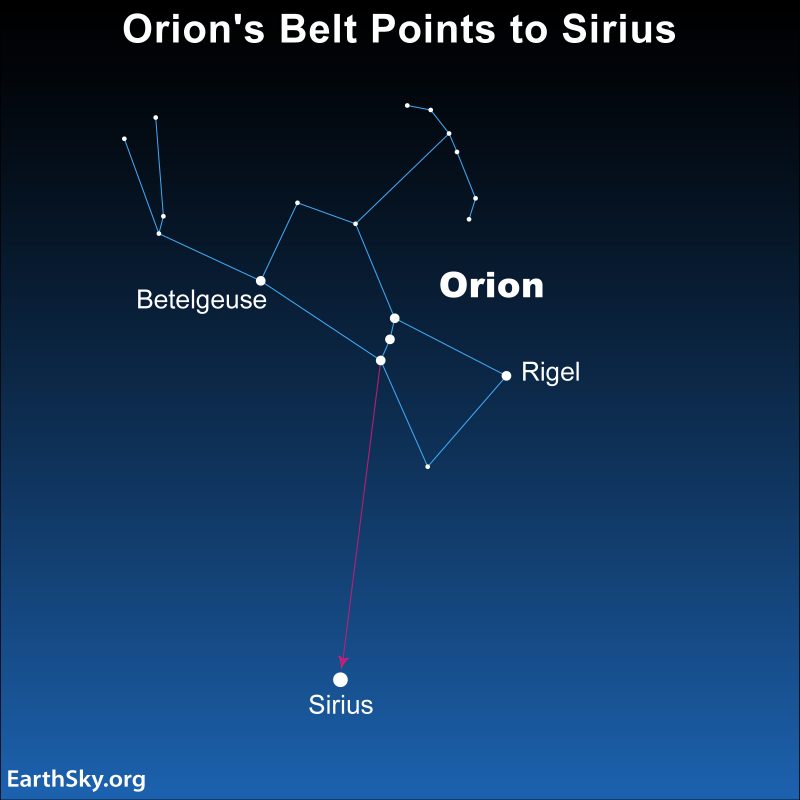
Brilliant Sirius as a southern Pole Star
On January evenings, use the Belt of Orion to star-hop to Sirius, a future southern Pole Star.
Believe it or not, the brightest star in the sky – our sparkling night beacon, Sirius in the constellation Canis Major the Greater Dog – will someday serve as a very reasonable, and certainly very noticeable, South Star.
Unlike the Northern Hemisphere, the Southern Hemisphere currently doesn’t have a bright pole star. There’s not even a moderately bright star – like our North Star Polaris – to mark the south celestial pole, the point in the sky directly over the Earth’s South Pole.
The pole star – either north or south – is the point around which the entire sky turns. It’s like the hub of a great wheel.
But not for a long, long time
We found the information about Sirius as a southern pole star in the book “Mathematical Astronomy Morsels V” by the great celestial mechanist Jean Meeus. See pages 353 to 363. Meeus wrote that Sirius will take its turn as the southern Pole Star some 60,000 years from now, around the year 66270. In that year, Sirius will come to within 1.6 degrees of the south celestial pole.
One precessional cycle later, in the year 93830, Sirius will miss aligning with the south celestial pole by only 2.3 degrees.
Stars close to the celestial poles
Our current North Star, Polaris, comes closer than that to the north celestial pole. Polaris will be within 0.5 degrees of the north celestial pole in the year 2100. For reference, the moon’s angular diameter spans 0.5 degrees of sky.
But the Southern Hemisphere will have its close pole star, too. A moderately bright star, not very different in brightness from Polaris, will take its place more or less over the south celestial pole about 7,000 years from now. Because of precession, the star Delta Velorum in the constellation Vela the Sail will come to within 0.2 degrees of the south celestial pole in the year 9250. That’s closer to marking the celestial pole than Polaris or Sirius ever do during their reigns as pole stars!
Was Sirius a pole star in the past?
A reader asked us:
Sirius will be the southern pole star around 66,270 AD. Was Sirius the southern pole star in the past as well?
Because of the 26,000-year precession of our planet, it would seem like Sirius gets to be the south celestial pole star every 26,000 years. But the answer is actually no, Sirius was not a pole star in the past, and it won’t be a pole star anytime between now and 66,270 AD.
The reason is because Sirius is so close to us. Sirius, the brightest star seen from Earth, is bright because of how close it is. And being close to us, it appears to move faster than other stars in the sky. Scientists say it has a high rate of proper motion. At Tony Dunn’s website, you can scroll down to Canis Major, Sirius’s home constellation, and click to watch an animation of how Sirius’s fast motion (relatively speaking) changes the look of the Greater Dog.
So, Sirius is not currently close to the south celestial pole or even the circle that the precession draws out on the southern sky. But it is heading that way and will close in on the south celestial pole by 66,270 AD. Orbital simulation expert Tony Dunn also has a great video showing the movement of the south celestial pole for the next 150,000 years or so. Watch how many years elapse before Sirius finally enters the scene, nearly halfway through the video as it crosses the southern sky.
Pole stars do come in handy
A pole star is a handy star to have in the sky. Some people mistakenly think Polaris is the sky’s brightest star, because it really is such an important star. It’s not all that bright, though. It’s a modestly bright star in the constellation Ursa Minor the Lesser Bear. In fact, Polaris marks the end of the handle of the Little Dipper asterism, which lies within the Bear constellation. As our North Star, Polaris stays fixed (relatively speaking), while all the stars of the northern sky wheel around it. That means that – if you know Polaris, and you get lost – this star can help you regain your bearings.

Bottom line: Nighttime’s brightest star, Sirius aka the Dog Star, will come to within 1.6 degrees of the south celestial pole in the year 66270.











